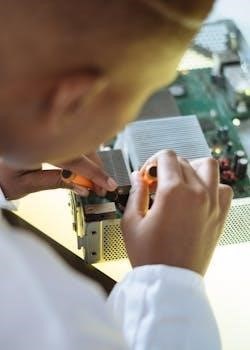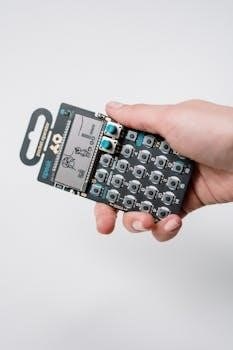The “Electronic Devices Conventional Current Version 9th Edition Solution Manual” offers comprehensive, step-by-step solutions to problems from the textbook, aiding students in mastering electronic device concepts and applications effectively.
Overview of Electronic Devices 9th Edition
The “Electronic Devices, Conventional Current Version, 9th Edition” serves as a foundational textbook in electronics, extensively covering semiconductor devices and circuits. This edition emphasizes a conventional current flow approach, crucial for understanding traditional circuit analysis techniques. It provides a detailed exploration of diodes, transistors (BJTs and FETs), amplifiers, and other essential electronic components.
The textbook’s structure includes numerous examples, practice problems, and real-world applications, enhancing student comprehension. It bridges theoretical concepts with practical implementations, preparing students for advanced studies and professional practice. The 9th edition incorporates updated content and pedagogical features, ensuring relevance in the rapidly evolving field of electronics.
Thomas L. Floyd as Author
Thomas L. Floyd is a highly regarded author in electronics education, known for his clear and accessible writing style. His textbook, “Electronic Devices, Conventional Current Version,” is a staple in electronics curricula worldwide. Floyd’s expertise lies in simplifying complex concepts, making them understandable for students with varying backgrounds.
Floyd’s approach emphasizes practical application and problem-solving, equipping students with the skills needed for real-world engineering challenges. He meticulously crafts examples and exercises that reinforce learning and promote critical thinking. With numerous successful editions, Floyd has consistently updated his materials to reflect advancements in electronics technology, ensuring his textbooks remain relevant and effective learning resources for aspiring engineers and technicians.

Availability of Solutions
Solutions for the textbook are available through various online platforms, including Chegg Study and Numerade, offering students multiple avenues for accessing step-by-step problem solutions.
Chegg Study Solutions
Chegg Study provides detailed, expert-verified solutions for the “Electronic Devices Conventional Current Version 9th Edition;” Unlike static PDF solution manuals, Chegg offers a step-by-step approach, clarifying each problem-solving process. This interactive method eliminates the need to wait for office hours or graded assignments, allowing students to promptly identify and correct errors in their work.
With Chegg Study, students gain a deeper understanding of the material through clear explanations and guided solutions, enhancing their learning experience. Expert assistance ensures accuracy and reliability, fostering confidence in tackling complex homework assignments. Chegg’s platform facilitates efficient and effective learning, empowering students to excel in their studies.
Textbook Solutions on Numerade
Numerade offers comprehensive textbook solutions for “Electronic Devices, Conventional Current Version, 9th Edition” by Thomas L. Floyd. Students gain access to step-by-step video explanations and answers to over 1,544 questions from the textbook. Numerade’s resources enhance understanding and problem-solving skills in electronic devices.
Numerade allows students to work directly from the textbook, providing detailed solutions and video explanations for each problem. This interactive approach helps in grasping complex concepts and improving overall performance. By using Numerade, students can access expert guidance and support to succeed in their electronic devices coursework. The platform offers a free trial for accessing solutions.
Content Covered in the Solution Manual
The solution manual provides detailed answers and step-by-step solutions for all exercises and examples in the textbook, aiding students in understanding and mastering electronic device concepts.
Step-by-Step Problem Solutions
The solution manual for “Electronic Devices Conventional Current Version 9th Edition” offers detailed, step-by-step solutions to all problems presented in the textbook. These solutions are designed to guide students through the problem-solving process, enhancing their understanding of electronic device principles. Each solution provides a clear and methodical approach, breaking down complex problems into manageable steps.
The step-by-step format enables students to follow the reasoning and calculations involved in arriving at the correct answer. This approach promotes active learning and reinforces key concepts. Furthermore, it helps students identify areas where they may need additional review or clarification. The solutions incorporate relevant formulas, diagrams, and explanations to ensure comprehensive understanding. By working through these detailed solutions, students can develop their problem-solving skills and gain confidence in their ability to analyze and design electronic circuits.
Exercises and Examples Solutions
The “Electronic Devices Conventional Current Version 9th Edition” solution manual includes comprehensive solutions for all exercises and examples featured in the textbook. These solutions are meticulously crafted to provide students with a clear understanding of how to apply theoretical concepts to practical problems. Each solved exercise and example serves as a valuable learning tool, reinforcing key principles and demonstrating effective problem-solving strategies.
The solutions detail each step involved, ensuring that students can follow the logic and reasoning behind the answers. Furthermore, the manual often includes alternative approaches and explanations, catering to different learning styles. By studying these worked-out exercises and examples, students can enhance their ability to analyze circuits, troubleshoot problems, and design electronic systems. The solutions are an indispensable resource for students seeking to master the material presented in the textbook.

Related Editions and Versions
Besides the Conventional Current Version, the “Electronic Devices” textbook also exists in an Electron Flow Version, as well as subsequent editions like the 10th Edition, offering updated content.
Electronic Devices Electron Flow Version
The “Electronic Devices Electron Flow Version” represents an alternative approach to teaching electronics, differing from the conventional current version in its explanation of current flow. This version emphasizes the movement of electrons, which is the actual physical phenomenon, moving from negative to positive. This approach can be conceptually easier for some students to grasp initially, as it aligns more closely with the fundamental physics of charge movement. However, understanding both conventions is crucial for a comprehensive understanding of electronics.
Instructors often choose between the conventional and electron flow versions based on their teaching style and the preferences of their students. Both versions cover the same core topics in electronic devices, including diodes, transistors, amplifiers, and digital circuits. The key difference lies in the method of explaining current direction, which impacts how circuits are analyzed and understood. Regardless of the version chosen, a solid foundation in basic circuit theory is essential for success in electronics.
Electronic Devices 10th Edition
The “Electronic Devices 10th Edition” is a more recent iteration of the textbook, likely containing updated content, revised examples, and potentially new topics compared to the 9th edition. Textbooks evolve to reflect changes in technology, industry standards, and pedagogical approaches. The 10th edition might incorporate newer devices, advanced circuit analysis techniques, or enhanced simulation tools. Students using the 9th edition solution manual should be aware of potential differences in problem sets and content organization.
Upgrading to the 10th edition is often recommended to ensure access to the most current information and best practices in electronics. However, the core principles remain consistent across editions, so a strong understanding of the 9th edition can still provide a solid foundation. Consider consulting the table of contents and preface of the 10th edition to identify key changes and additions. Also verify if a new solution manual is available for this edition.

Where to Find the Solution Manual
The solution manual can be found on online marketplaces like Amazon or eBay, and potentially through university resources such as the campus bookstore or library.
Online Marketplaces
Online marketplaces such as Amazon and eBay are common sources for obtaining the “Electronic Devices Conventional Current Version 9th Edition” solution manual. These platforms often host various sellers offering the manual in different formats, including digital downloads or physical copies. When searching on these marketplaces, it’s crucial to verify the seller’s reputation and ensure the manual specifically covers the 9th edition with the conventional current version.
Customers should also carefully review product descriptions and user reviews to confirm the manual’s accuracy and completeness. Prices can vary significantly between sellers, so comparing different listings is advisable to find the best deal. Additionally, be aware of potential copyright restrictions and only purchase from legitimate sources to avoid obtaining unauthorized or pirated copies of the solution manual.
University Resources
University resources can be valuable avenues for finding the “Electronic Devices Conventional Current Version 9th Edition” solution manual. University libraries often maintain copies of solution manuals for textbooks commonly used in their engineering programs. Students should check the library’s catalog or consult with a librarian to determine if the solution manual is available.
Additionally, some university engineering departments or professors may provide access to solution manuals through course websites or online learning platforms. Students enrolled in relevant courses should inquire with their instructors about the availability of the solution manual. Tutoring centers or academic support services within the university might also possess copies of the manual for student use. It is important to adhere to university policies regarding the use of solution manuals and to utilize them as a supplement to learning rather than a substitute for independent problem-solving.

Using the Solution Manual Effectively
To effectively use the solution manual, focus on understanding the problem-solving process. Avoid simply copying answers; instead, analyze each step to reinforce learning and comprehension.
Understanding Solution Steps
To maximize the benefit of the solution manual, prioritize understanding each step in the problem-solving process. Avoid rote memorization and instead, focus on grasping the underlying concepts and principles that guide each calculation or derivation. Analyze why specific formulas or techniques are applied in each scenario, connecting them to the relevant theory explained in the textbook.
Pay close attention to the logical flow of the solution, identifying the critical decision points and the rationale behind them. Actively work through examples, comparing your approach with the solution manual’s, and identifying any discrepancies in your understanding. This active engagement fosters deeper learning and enhances your problem-solving skills.
Supplementing Learning
The solution manual should be viewed as a supplement to, not a replacement for, active learning. Utilize it primarily to verify your understanding and identify areas needing further attention. Before consulting the solutions, attempt to solve problems independently, reinforcing your grasp of the material.
If you encounter difficulties, carefully review the relevant sections in the textbook and explore additional resources, such as online tutorials or lectures. Once you’ve exhausted these resources, consult the solution manual for guidance. After understanding the solution, revisit similar problems to solidify your knowledge. Consider forming study groups to discuss concepts and approaches with peers, enhancing collaborative learning.
